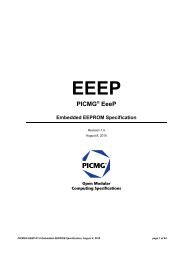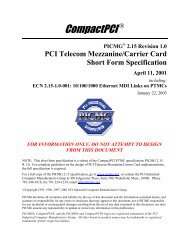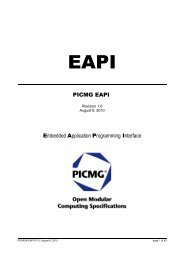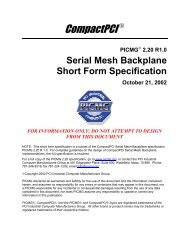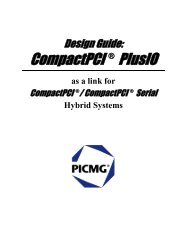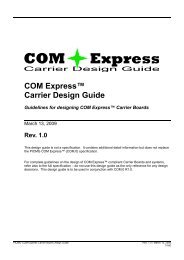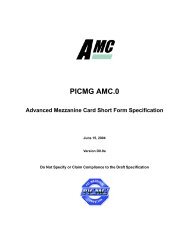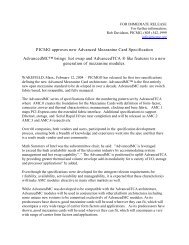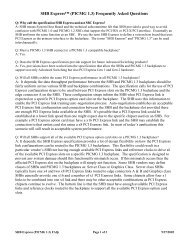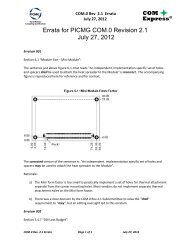PICMG 2.16, CompactPCI Packet Switching Backplane
PICMG 2.16, CompactPCI Packet Switching Backplane
PICMG 2.16, CompactPCI Packet Switching Backplane
Create successful ePaper yourself
Turn your PDF publications into a flip-book with our unique Google optimized e-Paper software.
<strong>PICMG</strong> ® <strong>2.16</strong> R1.0 Short Form Specification<br />
<strong>CompactPCI</strong>/PSB is bit-rate scalable; a single pinout supports a physical interface at rates of 10,<br />
100, or 1000 Mbps on a slot-by-slot basis (up to two links per slot). The <strong>CompactPCI</strong>/PSB<br />
supports full-duplex bit rates of up to 2000 Mbps per slot. A twenty-one slot PSB supports a<br />
total bandwidth approaching 40 Gbps. Redundant switching fabrics allow for the creation of<br />
High Availability (HA) systems. Connector and connector pin utilization is minimized (16<br />
active pins on P3/J3), thus allowing all <strong>PICMG</strong> 2.x Specifications to coexist on P1/J1, P2/J2,<br />
P4/J4, and P5/J5, with the exception of <strong>PICMG</strong> 2.3, because it has not been developed to support<br />
differential pair signaling.<br />
The <strong>CompactPCI</strong>/PSB includes well-defined subsets so that economical low-end systems can be<br />
built. A twenty-one slot backplane can be scaled from 10 to 1000 Mbps per port, one to two<br />
ports per slot; two to nineteen (Node) slots per chassis; and one to two purpose-built (Fabric)<br />
slots.<br />
PACKET SWITCHING BACKPLANE OVERVIEW<br />
A <strong>Packet</strong> <strong>Switching</strong> <strong>Backplane</strong> is composed of Node Slots, Fabric Slots, and the Links that<br />
interconnect them. The PSB topology is a star (not a bus) as shown in Figure 2. Each line<br />
interconnecting a Node Board and Fabric Board represents a Link that is a 10/100/1000 Mbps<br />
full-duplex Ethernet connection. Node Boards communicate by transferring/receiving packets<br />
to/from the Fabric Board, which transfers the packet to/from one or more Node Boards. Thus,<br />
every Node Board can communicate with every other Node Board and form a fabric.<br />
NODE<br />
NODE<br />
NODE<br />
NODE<br />
NODE<br />
NODE<br />
NODE<br />
NODE<br />
FABRIC<br />
SWITCH<br />
BOARD<br />
SWITCH<br />
NODE<br />
NODE<br />
NODE<br />
NODE<br />
NODE<br />
NODE<br />
NODE<br />
NODE<br />
Figure 2 Single Fabric PSB Topology<br />
Figure 3 shows the physical interconnections after adding a second switch to the system and a<br />
second Link Port to each Node. Two Link Ports of a single Node Board are wired to each of the<br />
two Fabric Boards. An optional Link is defined between Fabric ‘a’ and Fabric ‘b’ that is<br />
10/100/1000 Mbps capable.<br />
FOR INFORMATION ONLY;<br />
DO NOT ATTEMPT TO DESIGN FROM THIS DOCUMENT




